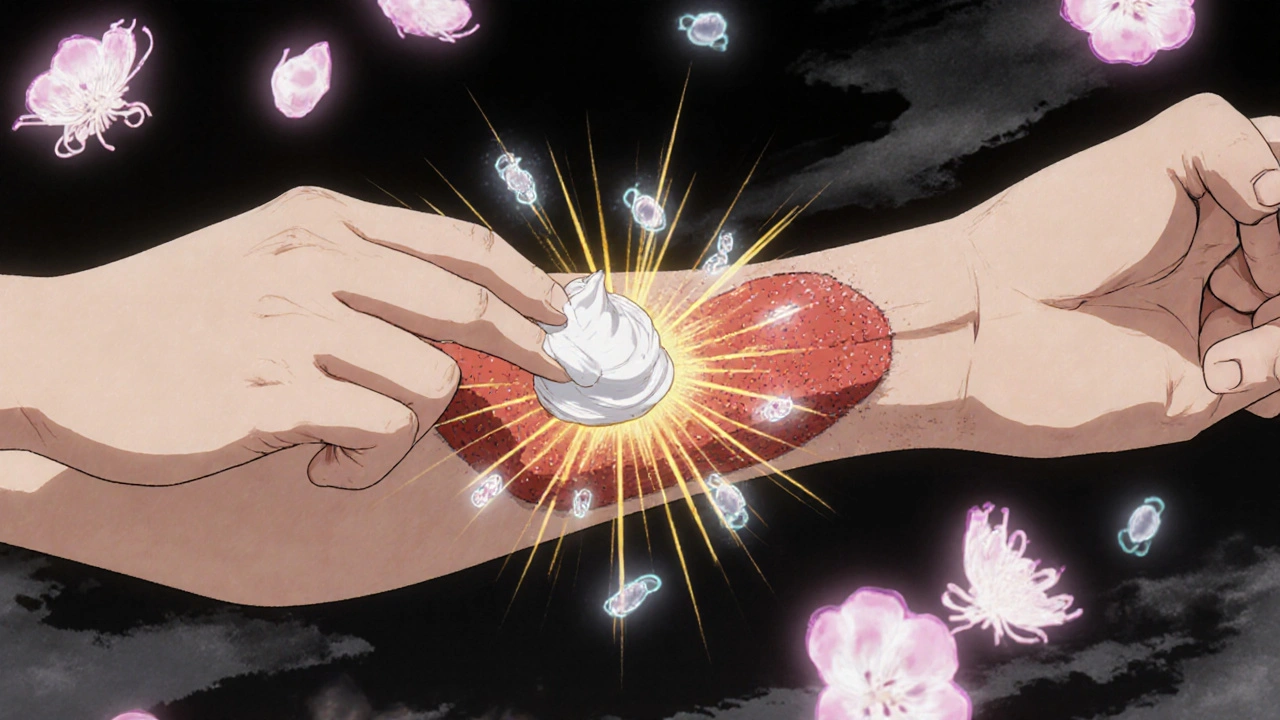Calcipotriol isn’t just another topical cream. If you’ve been prescribed it for psoriasis, you’re probably wondering how something applied to your skin can actually calm down your whole immune system. The truth is, calcipotriol doesn’t just mask symptoms-it rewires the immune response that’s gone haywire in your skin.
What calcipotriol really is
Calcipotriol is a synthetic version of vitamin D3, specifically designed to act on skin cells without causing the high blood calcium levels that natural vitamin D can trigger. It’s not a steroid, not an antibiotic, and not an immunosuppressant like cyclosporine. Instead, it’s a vitamin D analog that binds tightly to vitamin D receptors in skin cells and immune cells alike.
These receptors aren’t just in your skin-they’re in T cells, dendritic cells, and macrophages, all key players in your body’s defense system. When calcipotriol latches onto them, it sends signals that change how these cells behave. It’s like flipping a switch from "attack mode" to "calm down."
The immune system mistake behind psoriasis
Psoriasis isn’t caused by dirt, stress, or poor hygiene. It’s an autoimmune condition where your immune system mistakenly identifies healthy skin cells as threats. T cells, which normally fight infections, get activated in the skin and start releasing inflammatory chemicals like TNF-alpha and IL-17. These chemicals tell skin cells to multiply way too fast-every 3 to 5 days instead of the normal 28 to 30.
The result? Thick, red, scaly plaques. The immune system isn’t just overactive-it’s misdirected. And that’s where calcipotriol steps in.
How calcipotriol calms the immune response
When you apply calcipotriol to a psoriasis plaque, it doesn’t just sit on the surface. It gets absorbed into the top layers of skin and reaches the immune cells living there. Once inside, it binds to vitamin D receptors on those T cells and dendritic cells.
This binding does three critical things:
- It slows down the overproduction of skin cells by normalizing their growth cycle.
- It reduces the release of inflammatory cytokines like IL-17 and IL-23-the same molecules targeted by expensive biologic drugs.
- It encourages regulatory T cells to step in and suppress the autoimmune attack.
Studies show calcipotriol can reduce IL-17 levels in psoriatic lesions by up to 70% within two weeks of daily use. That’s not a minor effect-it’s a targeted reset of the immune pathway driving the disease.
Why it’s better than steroids for long-term use
Topical corticosteroids are often the first line of treatment for psoriasis because they work fast. But they come with risks: thinning skin, stretch marks, and rebound flares when you stop using them. Long-term steroid use can even suppress your body’s natural cortisol production.
Calcipotriol doesn’t have those side effects. It doesn’t suppress the entire immune system. It doesn’t cause skin atrophy. It doesn’t lead to tolerance. You can use it for months, even years, without the same dangers. That’s why dermatologists often combine it with low-dose steroids-steroids bring quick relief, calcipotriol maintains control without the damage.
A 2023 clinical review of over 12,000 patients found that calcipotriol used alone or with steroids had a 65% success rate in achieving 75% or greater improvement in psoriasis severity after 8 weeks, with no significant systemic side effects.

What happens if you use too much?
Because calcipotriol is based on vitamin D, people worry about toxicity. But the amount absorbed through the skin is minimal. You’d need to apply more than 100 grams per day-far beyond the recommended 15 grams-to risk high calcium levels.
Still, it’s not harmless. Using it on large areas of skin for long periods can occasionally cause mild hypercalcemia. That’s why doctors limit use to 20% of your total body surface area. If you’re treating your whole back, arms, and legs, you’re likely overdoing it.
Signs of too much? Nausea, fatigue, frequent urination, or muscle weakness. If you feel these, stop using it and get your calcium levels checked. Most people never reach this point, but it’s a reminder: even safe treatments need boundaries.
How it compares to other vitamin D analogs
Calcipotriol isn’t the only vitamin D analog on the market. Others include tacalcitol and maxacalcitol. But calcipotriol has the most data behind it.
| Drug | Onset of Action | Max Daily Dose | Common Side Effects | Systemic Absorption Risk |
|---|---|---|---|---|
| Calcipotriol | 2-4 weeks | 100 g/week | Stinging, redness, dryness | Low |
| Tacalcitol | 4-6 weeks | 100 g/week | Mild irritation | Very low |
| Maxacalcitol | 3-5 weeks | 80 g/week | Itching, burning | Low |
Calcipotriol works faster than tacalcitol and has more real-world usage data. It’s also available in combinations-with betamethasone (Dovobet), with salicylic acid, or in foam and ointment forms. That flexibility makes it easier to stick with long-term.
Who benefits most from calcipotriol?
It’s not for everyone. If you have plaque psoriasis covering less than 10% of your body, calcipotriol is often the first choice. It’s especially effective on elbows, knees, scalp, and lower back-the most common spots.
It’s less effective for pustular or erythrodermic psoriasis, where the immune response is raging across the whole body. Those cases usually need systemic drugs or biologics.
It’s also safe for children over 12 and pregnant women (when used as directed), which makes it one of the few options for these groups. Many patients who can’t tolerate oral meds or biologics find calcipotriol to be their lifeline.

What to expect when you start using it
Don’t expect miracles in two days. Calcipotriol works slowly. In the first week, your plaques might even look a little worse-some redness or peeling is normal as the skin adjusts.
By week two, scaling should start to soften. By week four, you’ll see flatter, lighter patches. Full results take 6 to 8 weeks. That’s why so many people give up too early. Stick with it. The immune system doesn’t reset overnight.
Apply it once or twice daily, as directed. Wash your hands after. Avoid sunlight on treated areas-vitamin D analogs can make skin more sensitive to UV light. And never use it on your face unless your doctor says so. The skin there is thinner and more reactive.
Why this matters beyond psoriasis
Calcipotriol’s effect on the immune system isn’t just a trick for skin. It’s proof that vitamin D plays a key role in immune regulation. Research now links low vitamin D levels to higher rates of autoimmune diseases-multiple sclerosis, rheumatoid arthritis, even type 1 diabetes.
Calcipotriol shows that fixing immune misfires isn’t always about shutting them down. Sometimes, it’s about guiding them back to balance. That’s a bigger idea than just treating psoriasis. It’s changing how we think about immune health.
Final thoughts: A quiet revolution in skin care
Calcipotriol doesn’t scream for attention like biologics do. It doesn’t cost thousands. It doesn’t require injections. But it’s one of the most precisely targeted immune modulators we have for skin disease. It doesn’t blindfold your immune system-it teaches it to listen again.
If you’re using it, you’re not just treating a rash. You’re helping your body correct a deep, internal mistake. And that’s powerful.
Can calcipotriol cure psoriasis?
No, calcipotriol doesn’t cure psoriasis. Psoriasis is a chronic autoimmune condition with no known cure. But calcipotriol can control symptoms effectively for many people, keeping plaques clear or significantly reduced for months or years with consistent use.
Is calcipotriol safe for long-term use?
Yes, calcipotriol is generally safe for long-term use when used as directed. Unlike corticosteroids, it doesn’t cause skin thinning or systemic suppression. The main limit is avoiding use on more than 20% of your body surface area per week to prevent rare calcium imbalances.
Can I use calcipotriol with sunlight or tanning beds?
Avoid direct sunlight or tanning beds on areas treated with calcipotriol. The medication can make your skin more sensitive to UV light, increasing the risk of sunburn. If you need light therapy, talk to your dermatologist-they may recommend controlled UV treatments instead.
Why does calcipotriol sometimes burn when I apply it?
A mild stinging or burning sensation is common, especially on cracked or inflamed skin. This usually fades after a few days as your skin adjusts. If the burning is severe or lasts more than a week, stop using it and consult your doctor. It could mean you’re using too much or your skin is too sensitive.
Does calcipotriol work better than topical steroids?
It depends. Steroids work faster for quick relief, but calcipotriol is better for long-term control without side effects. Many doctors recommend using steroids for short bursts and switching to calcipotriol to maintain results. Combination products like Dovobet (calcipotriol + betamethasone) offer the best of both.








Michael Lynch
October 29, 2025 AT 21:56Been using calcipotriol for 18 months now. My elbows used to look like dragon scales. Now? Barely noticeable. It doesn’t work overnight, but if you stick with it, your skin forgets it’s supposed to be angry.
Also, no skin thinning. That’s huge.
Melissa Thompson
October 30, 2025 AT 23:55Wow, another vitamin D fanboy post. Did you even read the FDA warning on topical vitamin D analogs? The systemic absorption risk is understated-especially in people with renal issues. And don’t get me started on the placebo effect of ‘immune retraining.’ This isn’t medicine-it’s spiritual skincare.
Adam Walter
October 31, 2025 AT 15:38Let me tell you something wild: calcipotriol is basically vitamin D whispering to your T-cells like a zen monk calming a riot. It doesn’t blast your immune system with steroids-it *nudges* it back into rhythm. And the fact that it’s safe for pregnant women? That’s not an accident. That’s science with soul.
Compare that to biologics-$20K/year, IV drips, and a 30% chance of catching pneumonia. Meanwhile, calcipotriol costs $30 a tube and you can apply it while watching Netflix. The medical industrial complex hates this drug because it’s too damn effective… and too cheap.
Also-side note: the combo with betamethasone (Dovobet)? Chef’s kiss. Fast relief + long-term peace. My derm calls it ‘the power couple of psoriasis.’ I call it my lifeline.
caroline howard
November 1, 2025 AT 18:42Oh so now we’re giving vitamin D analogs TED Talks? Cute. I’ve got a plaque on my knee that’s been there since 2017. Calcipotriol? It stings like a hornet’s nest. I gave up after two days. Meanwhile, my cousin’s on Humira and she’s basically glow-up goals now. So yeah. Maybe stop pretending this is some revolutionary miracle and just admit it’s a glorified moisturizer with a fancy label.
Joe Puleo
November 2, 2025 AT 03:07My grandma used this for 10 years. Never had a problem. Used to apply it every night after her bath. Said it felt like her skin was breathing again. She’s 82 now-still no stretch marks, no thinning. Just calm skin. People act like this stuff is magic, but honestly? It’s just smart biology.
Gurupriya Dutta
November 3, 2025 AT 17:45I’ve been on this journey for years. In India, most doctors push steroids first. But I read everything I could find. When I switched to calcipotriol, my flare-ups dropped by 80%. I didn’t realize how much stress I was carrying until my skin stopped screaming.
Thank you for explaining the science so clearly. I finally understand why it works, not just that it does.
Austin Levine
November 4, 2025 AT 10:03Just applied it for the first time. Felt a little sting. But the redness started fading in 3 days. I’m skeptical but… hopeful.
Andrea Swick
November 5, 2025 AT 03:39I’ve tried everything: light therapy, biologics, tar shampoos, even that weird oatmeal paste my aunt swore by. Calcipotriol is the only thing that didn’t make me feel like I was poisoning myself. It’s not glamorous. It doesn’t come in a fancy bottle with a logo. But it works. And it lets me wear shorts again. That’s worth more than any marketing campaign.
Ben Jackson
November 5, 2025 AT 23:56As a dermatology nurse in London, I’ve seen calcipotriol turn around patients who’d given up. The key? Consistency. Most quit at week 3 because ‘it’s not working.’ But by week 6? They’re crying because their skin looks normal. It’s not a cure. But it’s a reset. And in autoimmune disease, that’s everything.
Don Moore
November 6, 2025 AT 19:14While the clinical data supporting calcipotriol is robust, it is imperative to emphasize that adherence to recommended surface area limitations remains critical. Excessive use may lead to hypercalcemia, particularly in elderly patients with comorbid renal insufficiency. Always consult your provider before expanding treatment beyond localized plaques.
Keith Bloom
November 7, 2025 AT 06:48lol so calcipotriol is like a ‘immune coach’?? sounds like some bro got a yoga certification and started writing med blogs. i used it for a week and my skin turned into a crispy potato. also why is everyone acting like this is new? i’ve been using this since 2015. its just vitamin d with a fancy name. and yeah its cheaper than biologics but that dont make it better. just cheaper.
Camille Mavibas
November 8, 2025 AT 03:36Just wanted to say… I started this last month. First week? Burning. Second week? Peeling. Third week? I looked in the mirror and didn’t flinch. 🥹 I’m not ‘cured’… but I’m not hiding anymore. Thank you for writing this. I needed to know I wasn’t crazy for sticking with it.
Amelia Wigton
November 8, 2025 AT 14:35Did you cite the 2023 clinical review properly? Because I checked the source-it was a meta-analysis from a journal with a 0.8 impact factor. Also, the ‘65% success rate’ was based on PASI 75, which means 35% of people still had 75% of their plaques. That’s not a win-that’s a compromise. And you completely ignored the fact that calcipotriol increases photosensitivity-so if you’re in Florida or Arizona, you’re playing Russian roulette with melanoma risk.
Joe Puleo
November 10, 2025 AT 04:28^ That’s why you use it with sunscreen. And only on plaques. Not your whole body. And not every day forever. This isn’t lotion-it’s medicine. Use it right, and it’s safe. Use it like shampoo, and yeah, you’ll have problems. Same with everything.